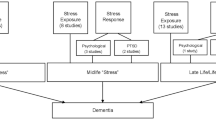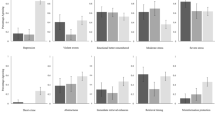Abstract
Visual stress is thought to reflect cortical excitability and has been associated with many neurological, neuropsychiatric, and neurodevelopmental conditions. However, its relationships with symptoms of depression and anxiety have not yet been elucidated. We conducted two separate studies to first examine visual stress in a longitudinal community sample of 104 participants (aged 12–24) in association with prospective symptoms of depression, anxiety, and distress after 3 months, and subsequently in a cross-sectional epidemiological sample of 530 participants (aged 15–24) to validate its associations with current mood and distress symptoms. The Pattern Glare Test was used to examine visual stress to three grating patterns with the spatial frequencies (SF) of 0.3, 2.3, and 9.4 cycles per degree (cpd). Other known factors of mental health, including functioning, as well as resilience, hopelessness, and loneliness, were also assessed at baseline. In both studies, we showed that perceptual distortions were highest toward the pattern with mid-SF (2.3 cpd). Multiple linear regression analyses revealed that greater visual stress was significantly associated with not only baseline but also 3-month symptom outcomes, even when accounting for age, years of education, days of no functioning, resilience, hopelessness, and loneliness. Our findings suggest the importance of visual stress in understanding and predicting poor mental health outcomes. As mental health can lead to far-reaching consequences that extend to adulthood, our findings may inform state-of-the-art innovative strategies for the prediction of poor mental health outcomes and suggest visual stress as a potential marker for early risk detection among young people.
Similar content being viewed by others
Availability of data and materials
Data are available upon reasonable request.
References
Wilkins A, Nimmo-Smith I, Tait A, McManus C, Sala SD, Tilley A, Arnold K, Barrie M, Scott S (1984) A neurological basis for visual discomfort. Brain 107:989–1017. https://doi.org/10.1093/brain/107.4.989
Wilkins AJ, Evans BJW (2001) Pattern glare test instructions. IOO Sales Ltd, London
Evans BJW, Stevenson SJ (2008) The Pattern Glare Test: a review and determination of normative values. Ophthalmic Physiol Opt 28:295–309
Wilkins AJ, Evans BJ (2010) Visual stress, its treatment with spectral filters, and its relationship to visually induced motion sickness. Appl Ergon 41:509–515. https://doi.org/10.1016/j.apergo.2009.01.011
Huang J, Cooper TG, Satana B, Kaufman DI, Cao Y (2003) Visual distortion provoked by a stimulus in migraine associated with hyperneuronal activity. Headache 43:664–671. https://doi.org/10.1046/j.1526-4610.2003.03110.x
Meldrum BS, Wilkins AJ (1984) Electrophysiology and epilepsy. In: Schwartzkroin PA, Wheal HV (eds) Photosensitive epilepsy: integration of pharmacological and psychophysical evidence. Academic Press, London, pp 51–77
Aurora SK, Ahmad BK, Welch KM, Bhardhwaj P, Ramadan NM (1998) Transcranial magnetic stimulation confirms hyperexcitability of occipital cortex in migraine. Neurology 50:1111–1114. https://doi.org/10.1007/s00421-008-0955-8
Baldwin DS, Anderson IM, Nutt DJ, Bandelow B, Bond A, Davidson JRT, Boer JAD, Fineberg NA, Knapp M, Scott J, Wittchen HU, British Association for Psychopharmacology (2005) Evidence-based guidelines for the pharmacological treatment of anxiety disorders: recommendations from the British Association for Psychopharmacology. J Psychopharmacol 19:567–596. https://doi.org/10.1177/0269881105059253
Sanacora G, Gueorguieva R, Epperson CN, Wu YT, Appel M, Rothman DL, Krystal JH, Mason GF (2004) Subtype-specific alterations of γ-aminobutyric acid and glutamate in patients with major depression. Arch Gen Psychiatry 61:705–713. https://doi.org/10.1001/archpsyc.61.7.705
Qi X, Fan H, Yang X, Chen Y, Deng W, Guo W, Wang Q, Chen E, Li T, Ma X (2019) High level of pattern glare in major depressive disorder. BMC Psychiatry 19:1–7. https://doi.org/10.1186/s12888-019-2399-6
Hui CL, Suen YN, Lam BY, Wong SM, Wong CS, Lui SS, Chan KT, Wong MT, Chan SK, Lee EH, Chang WC, Wong GHY, Chen EYH (2021) LevelMind@ JC: Development and evaluation of a community early intervention program for young people in Hong Kong. Early Interv Psychiatry. https://doi.org/10.1111/eip.13261
Spitzer RL, Kroenke K, Williams JB, Patient Health Questionnaire Primary Care Study Group (1999) Validation and utility of a self-report version of PRIME-MD: the PHQ primary care study. J Am Med Assoc 282:1737–1744. https://doi.org/10.1001/jama.282.18.1737
Spitzer RL, Kroenke K, Williams JB, Löwe B (2006) A brief measure for assessing generalized anxiety disorder: the GAD-7. Arch Intern Med 166:1092–1097. https://doi.org/10.1001/archinte.166.10.1092
Kessler RC, Barker PR, Colpe LJ, Epstein JF, Gfroerer JC, Hiripi E, Howes MJ, Normand ST, Manderscheid RW, Walters EE, Zaslavsky AM (2003) Screening for serious mental illness in the general population. Arch Gen Psychiatry 60:184–189. https://doi.org/10.1001/archpsyc.60.2.184
Campbell-Sills L, Stein MB (2007) Psychometric analysis and refinement of the connor–davidson resilience scale (CD-RISC): Validation of a 10-item measure of resilience. J Trauma Stress 20(6):1019–1028
Beck AT, Steer RA (1998) Manual for the Beck hopelessness scale. Psychological Corporation, San Antonio
Russell DW (1996) UCLA Loneliness Scale (Version 3): reliability, validity, and factor structure. J Pers Assess 66:20–40. https://doi.org/10.1207/s15327752jpa6601_2
Round JM, Lee C, Hanlon JG, Hyshka E, Dyck JRB, Eurich DT (2020) Changes in patient health questionnaire (PHQ-9) scores in adults with medical authorization for cannabis. BMC Pub Health 20:1–10. https://doi.org/10.1186/s12889-020-09089-3
Wong SM, Ip CH, Hui CL, Suen YN, Wong CS, Chang WC, Chan SK, Lee EH, Lui SS, Chan KT, Wong MT, Chen EYH (2022) Prevalence and correlates of suicidal behaviours in a representative epidemiological youth sample in Hong Kong: the significance of suicide-related rumination, family functioning, and ongoing population-level stressors. Psychol Med. https://doi.org/10.1017/S0033291722001519
Wong SM, Lam BY, Wong CS, Lee HP, Wong GH, Lui SS, Chan KT, Wong MT, Chan SK, Chang WC, Lee EH, Suen YN, Hui CLM, Chen EYH (2022) Measuring subjective stress among young people in Hong Kong: validation and predictive utility of the single-item subjective level of stress (SLS-1) in epidemiological and longitudinal community samples. Epidemiol Psychiatric Sci 30:e61. https://doi.org/10.1017/S2045796021000445
Lovibond PF, Lovibond SH (1995) The structure of negative emotional states: comparison of the Depression Anxiety Stress Scales (DASS) with the beck depression and anxiety inventories. Behav Res Ther 33(3):335–343
Conlon E, Lovegrove W, Barker S, Chekaluk E (2001) Visual discomfort: the influence of spatial frequency. Perception 30:571–581. https://doi.org/10.1068/p2954
Kraemer HC, Noda A, O’Hara R (2004) Categorical versus dimensional approaches to diagnosis: methodological challenges. J Psychiatr Res 38:17–25. https://doi.org/10.1016/s0022-3956(03)00097-9
Luscher B, Shen Q, Sahir N (2011) The GABAergic deficit hypothesis of major depressive disorder. Mol Psychiatry 16:383–406. https://doi.org/10.1038/mp.2010.120
Andrews G (2018) Internalizing disorders: the whole is greater than the sum of the parts. World Psychiatry 17(3):302–303
Kotov R, Krueger RF, Watson D, Achenbach TM, Althoff RR, Bagby RM, Brown TA, Carpenter WT, Caspi A, Clark LA, Eaton NR (2017) The Hierarchical Taxonomy of Psychopathology (HiTOP): a dimensional alternative to traditional nosologies. J Abnorm Psychol 126:454–477
Dalgleish T, Black M, Johnston D, Bevan A (2020) Transdiagnostic approaches to mental health problems: current status and future directions. J Consult Clin Psychol 88(3):179–195
McQuaid RJ (2021) Transdiagnostic biomarker approaches to mental health disorders: Consideration of symptom complexity, comorbidity and context. Brain, Behav Immunity-Health 16:100303
Papakostas GI, Petersen T, Mahal Y, Mischoulon D, Nierenberg AA, Fava M (2004) Quality of life assessments in major depressive disorder: a review of the literature. Gen Hosp Psychiatry 26:13–17. https://doi.org/10.1016/j.genhosppsych.2003.07.004
Goldman-Mellor S, Caspi A, Arseneault L, Ajala N, Ambler A, Danese A, Fisher H, Hucker A, Odgers C, Williams T, Wong C, Moffitt TE (2016) Committed to work but vulnerable: Self-perceptions and mental health in NEET 18-year olds from a contemporary British cohort. J Child Psychol Psychiatry 57:196–203. https://doi.org/10.1111/jcpp.12459
Hammar Å, Årdal G (2009) Cognitive functioning in major depression-a summary. Front Hum Neurosci 3:26. https://doi.org/10.3389/neuro.09.026.2009
Harvey PO, Le Bastard G, Pochon JB, Levy R, Allilaire JF, Dubois B, Fossati P (2004) Executive functions and updating of the contents of working memory in unipolar depression. J Psychiatr Res 38:567–576. https://doi.org/10.1016/j.jpsychires.2004.03.003
Beck AT (1976) Cognitive therapy and the emotional disorders. International Universities Press, New York
Alford BA, Lester JM, Patel RJ, Buchanan JP, Giunta LC (1995) Hopelessness predicts future depressive symptoms: a prospective analysis of cognitive vulnerability and cognitive content specificity. J Clin Psychol 51:331–339. https://doi.org/10.1002/1097-4679(199505)51:3%3C331::AID-JCLP2270510303%3E3.0.CO;2-T
Graber R, Turner R, Madill A (2016) Best friends and better coping: facilitating psychological resilience through boys’ and girls’ closest friendships. Br J Psychol 107:338–358. https://doi.org/10.1111/bjop.12135
Wols A, Scholte RHJ, Qualter P (2015) Prospective associations between loneliness and emotional intelligence. J Adolesc 39:40–48. https://doi.org/10.1016/j.adolescence.2014.12.007
Erzen E, Çikrikci Ö (2018) The effect of loneliness on depression: a meta-analysis. Int J Soc Psychiatry 64:427–435. https://doi.org/10.1177/0020764018776349
Acknowledgements
We would like to thank and acknowledge the support and contribution from all participating young people, carers, and staff, as well as six collaborating community organizations (The Boys’ & Girls’ Club Association of Hong Kong, Caritas Hong Kong, The Hong Kong Federation of Youth Groups, Hong Kong Playground Association, St James’ Settlement, and Hong Kong Children & Youth Services) of the LevelMind@JC project. We also thank all the young people and staff of the HK-YES project.
Funding
This work was supported by funding from the Hong Kong Jockey Club Charities Trust (Funding Reference Number 2020/0012/001), as well as from the Food and Health Bureau, HKSAR Government (Funding Reference Number MHS-PI (Part2)).
Author information
Authors and Affiliations
Contributions
EYHC conceived and designed the study. TYTY, TTYL, OCYC, and ST performed data collection. EYHC, CLMH, SMYW, and TYTY analyzed the data. EYHC, CLMH, SMYW, TYTY, and AW interpreted the results. All authors reviewed and validated the data. CLMH, SMYW, and TYTY wrote the initial draft and completed initial revisions of the manuscript. All authors provided critical input to the drafts of the manuscript and approved the final manuscript.
Corresponding author
Ethics declarations
Conflict of interest
EYHC reports having received speaker honoraria from Otsuka and DSK BioPharma; received research funding from Otsuka; participated in paid advisory boards for Jansen and DSK BioPharma; received funding to attend conferences from Otsuka and DSK BioPharma. The remaining authors declare no competing interests.
Ethics approval
Both studies were approved by the Institutional Review Boards of the University of Hong Kong/Hospital Authority Hong Kong West Cluster and carried out in accordance with Good Clinical Practice and the Declaration of Helsinki.
Consent to participate
Written informed consent was obtained from all participants.
Rights and permissions
Springer Nature or its licensor holds exclusive rights to this article under a publishing agreement with the author(s) or other rightsholder(s); author self-archiving of the accepted manuscript version of this article is solely governed by the terms of such publishing agreement and applicable law.
About this article
Cite this article
Hui, C.LM., Wong, S.MY., Yu, T.YT. et al. Visual-stress-related cortical excitability as a prospective marker for symptoms of depression and anxiety in young people. Eur Arch Psychiatry Clin Neurosci 273, 1051–1060 (2023). https://doi.org/10.1007/s00406-022-01469-7
Received:
Accepted:
Published:
Issue Date:
DOI: https://doi.org/10.1007/s00406-022-01469-7




